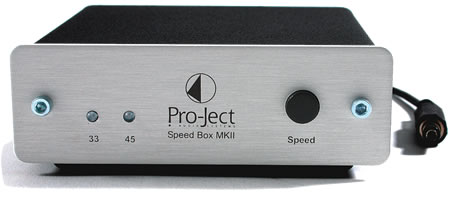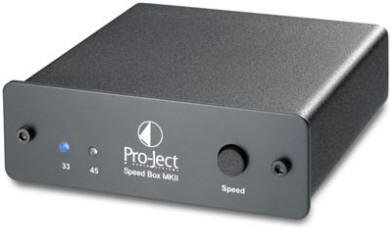
You are reading the older HTML site
Positive Feedback ISSUE
may/june 2007
pro-ject
Speed Box II
as reviewed by Adam Goldfine

|
Got a Henway?
Weighing in at just over a pound with a retail price of $119, I wasn't expecting much from the Pro-Ject Speed Box II. Even Pro-Ject's literature doesn't provide much by way of expounding its virtues other than to provide a simple laundry list of specs. So I wasn't quite sure if I would notice anything when I plugged the diminutive box into the motor of my Music Hall MMF-7 turntable.
What's a Henway?
The Speed Box II is a quartz-generated, high precision electronic speed control that is claimed to provide stable voltage and frequency controlled AC power to 16V AC turntable motors such as those found on many of Pro-Ject's own models, as well as various other Music Hall models. (I know the motor on the MMF-7 is often referred to as a 12V motor, but the included power supply is rated for 16V—its actual output is higher—so logic says it's a 16V motor.) It also permits electronic speed change from 33- to 45-RPM at the push of a button, as opposed to moving the belt to a larger or smaller motor pulley. Along with the Speed Box II, the package also includes a small wall wart power supply similar to the one provided with a turntable motor.
About a Pound and a Half.
Before settling in for a listen, I decided to break out my trusty multi-meter and see exactly what this thing was doing to the power. First, I measured the output voltage of the included wall wart, and found it to be 19.04V AC, significantly above the stated 16V. Wondering how it compared to the unit included with the turntable, a quick measurement of that unit showed an output voltage of 20.15V, also much higher than the 16V claimed specs. As long as the motor could handle the voltage, I didn't think it should be much of a problem, as the speed is controlled by the AC frequency, not the voltage. The frequency out of the wall, as well as the output of both wall warts was identical at 59.9Hz, very close to the nominal 60Hz.
The Speed Box II is said to control the frequency of the AC power being fed to the motor to within +/- .001 %. The included wall-wart powers the Speed Box, resulting in a cleaned up and stabilized output for the box to power the turntable motor. To use the Speed Box, the belt is placed on the larger 45-RPM pulley, and the speed box provides a lower frequency waveform running the motor more slowly while still turning the platter at 33.33-RPM. Pushing the 45-RPM button increases the AC frequency turning the motor faster and the platter at 45-RPM - providing electronic speed change at the push of the button. No fiddling with the belt and pulleys!
Plugging the box into the wall-wart and measuring the output voltage from the speed controller resulted in a more reasonable 16.83V and a frequency of 44.32Hz at the 33-RPM setting and, as expected, 59.9Hz at the 45-RPM setting.
A 1000Hz tone played back on the turntable without the Speed Box II resulted in a frequency of 993 Hz, +/- 0.1%. Slightly slow, but still acceptable and within the turntable's specs. Taking the same measurement with the Speed Box II powering the motor resulted in a frequency of 996Hz, +/- 0.1%. My meter doesn't have the resolution to measure if there was any appreciable difference in the speed stability.

The Sound
So how did it sound? I was quite surprised by the impact this little box had on the sound generated by the MMF-7. Certain improvements one might imagine are quite obvious. If the platter is turning at a stable speed, you could expect better pitch stability, and yes, there was. You could even reasonably expect more solid bass resulting from a reduction in the slight phase shifting effects of speed instability. However, what was really surprising was the lack of grain and the gain in transparency, as realized by this little box.
Not too long ago I heard Jamie Howarth interviewed by Robert Siegel on NPR's All Things Considered. Mr. Howarth created a software program that can correct gross speed variations of older analog tape and 35mm film masters restoring previously unlistenable tracks to pristine condition by correcting the speed errors. We are talking wow and flutter of 50% or more restored to rock solid stability! He also mentioned that during the process of creating this system he discovered that with high frequency speed variations (such as those found on modern turntables or the jitter generated in the digital decoding of CDs), the perception, rather than being an audible garble or warble, is of distortion, the sound becoming grainy and harsh. He called it analog jitter, noting that it is present on all recordings to some degree. (You can hear the original interview archived at http://www.npr.org/templates/story/story.php?storyId=7489316). So it stands to reason that spinning a turntable motor with greater speed stability should reduce grain and harshness and in this regard, the Speed Box did not disappoint.
The Speed Box II definitely allowed for a more relaxed and resolved presentation. Images became even more tightly focused, a touch of graininess I heard in Joni Mitchell's voice on "Help Me", Court and Spark (LP, Asylum Records 7E-1001) all but disappeared. Her voice seemed so present, it was as if she was practically the room. The opening drums on this track had previously sounded a bit thin and hollow, but they now possessed a solid foundation along with a richer, rounder tone. A sense of artificial edge disappeared, resulting in a more realistic and natural performance.
At first, I thought I heard a slight loss of dynamics, but soon realized that what I was hearing was greater detail and increased transient resolution with less of a hard edge on the attack. For example, the closed high hat work on Steely Dan's Aja (LP, ABC Records AA 1006) had always sounded splashy, hard, and poorly defined; sounding more like a wash of sound than a high hat. But with the Speed Box II driving the turntable motor, it sounded like two cymbals pressed together instead of an indistinct crash. The opening piano had greater weight and better pitch resolution with less warbling. A quieter background added to the sense of space around the instruments and the drums were now more tightly focused than before. Donald Fagen still sounded a bit recessed, though a chesty coloration largely disappeared.
The bass drum whacks on "The Infernal Dance of All Kastchei's Subjects" from Stravinsky's Firebird Suite, Erich Leinsdorf conducting the Los Angeles Philharmonic Orchestra (LP, Sheffield Lab LAB 24), have always been powerful and startling. Now they had greater resonance and tonal depth with no loss of impact resulting in a richer, more finely shaded presentation. During the rollercoaster-like crescendo, each melodic line remained fully intact with the timbral differences between horns even more distinct than without the Speed Box. By the way, this is sonically one of the best orchestral recordings I have ever heard and the performance is stirring to boot. If your system is up to it, it will put an orchestra in your living room. Get it if you can.
The Bottom Line
Well, I didn't expect much from this little box and I was more than a little surprised by the level of improvement it wrought from my system. You get substantially improved sound from your turntable and push button speed change to boot. The motor turning at a slower speed when playing back 33 RPM LPs is said to reduce motor noise though I can't say I heard any to begin with. Though the background did seem quieter and blacker. If I have any complaint it's that the power cord feeding the motor rather short limiting your placement options, especially if your turntable takes up most of your shelf. But for $119, you really can't go wrong. In fact, I would say it's one of the most cost effective improvements you can make to your system. If this little box works with your turntable, and you don't have an electronic speed control already, you are missing what your rig is truly capable of. Adam Goldfine
Speed Box II
Retail:
$119
Specifications
-
Model: Speed Box II
-
Nominal Speeds: 33 1/3 and 45 RPM
-
Speed Stability: +/- 0.001%
-
Output Voltage: 16V/500mA AC
-
Dimensions (WHD): 4 x 1.5 x 4.5 inches
-
Weight: 1 lb. 4 oz.
-
Serial # of review unit: 65386
-
Available Finishes: Silver or Black
-
Warranty: 2 years
Distributor
Sumiko Audio
web address:
www.sumikoaudio.net
